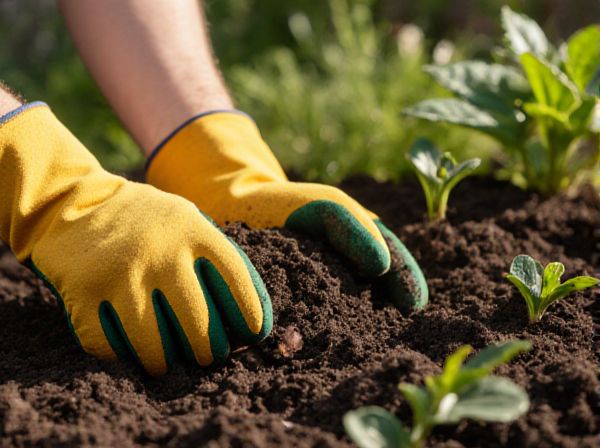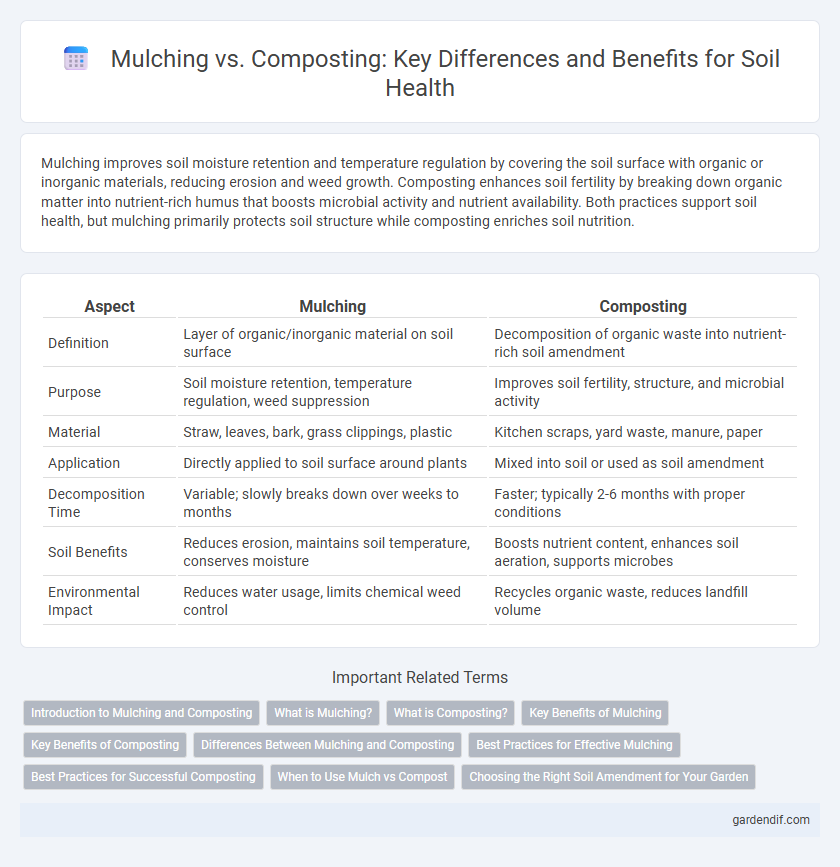
Mulching vs Composting Illustration
Mulching improves soil moisture retention and temperature regulation by covering the soil surface with organic or inorganic materials, reducing erosion and weed growth. Composting enhances soil fertility by breaking down organic matter into nutrient-rich humus that boosts microbial activity and nutrient availability. Both practices support soil health, but mulching primarily protects soil structure while composting enriches soil nutrition.
Table of Comparison
| Aspect | Mulching | Composting |
|---|---|---|
| Definition | Layer of organic/inorganic material on soil surface | Decomposition of organic waste into nutrient-rich soil amendment |
| Purpose | Soil moisture retention, temperature regulation, weed suppression | Improves soil fertility, structure, and microbial activity |
| Material | Straw, leaves, bark, grass clippings, plastic | Kitchen scraps, yard waste, manure, paper |
| Application | Directly applied to soil surface around plants | Mixed into soil or used as soil amendment |
| Decomposition Time | Variable; slowly breaks down over weeks to months | Faster; typically 2-6 months with proper conditions |
| Soil Benefits | Reduces erosion, maintains soil temperature, conserves moisture | Boosts nutrient content, enhances soil aeration, supports microbes |
| Environmental Impact | Reduces water usage, limits chemical weed control | Recycles organic waste, reduces landfill volume |
Introduction to Mulching and Composting
Mulching involves covering soil with organic or inorganic materials to conserve moisture, suppress weeds, and regulate soil temperature, enhancing soil structure and fertility. Composting transforms organic waste into nutrient-rich humus through microbial decomposition, enriching soil with essential nutrients and improving microbial activity. Both practices play critical roles in sustainable soil management by promoting soil health and boosting plant growth.
What is Mulching?
Mulching involves covering the soil surface with organic or inorganic materials such as straw, wood chips, or leaves to conserve moisture, regulate temperature, and suppress weeds. This practice improves soil structure by preventing erosion and enhancing microbial activity. Mulching also reduces water evaporation, promoting healthier plant growth and maintaining soil nutrient levels.
What is Composting?
Composting is a natural process that transforms organic waste, such as kitchen scraps and yard debris, into nutrient-rich humus that improves soil fertility and structure. It involves the controlled aerobic decomposition of biodegradable materials by microorganisms, resulting in a valuable soil amendment that enhances moisture retention and promotes healthy plant growth. Unlike mulching, which primarily protects the soil surface, composting supplies essential nutrients and boosts microbial activity within the soil ecosystem.
Key Benefits of Mulching
Mulching enhances soil moisture retention by reducing evaporation, promoting healthier plant growth and reducing water usage. It suppresses weed development, minimizing competition for nutrients and decreasing the need for chemical herbicides. Mulching also stabilizes soil temperature, protecting plant roots from extreme heat and cold while improving soil structure and nutrient availability.
Key Benefits of Composting
Composting enriches soil by introducing vital nutrients and improving its structure, promoting healthier plant growth and increased microbial activity. It enhances moisture retention and reduces erosion, making soil more resilient to environmental stress. Organic matter from composting also supports sustainable waste management by recycling garden and kitchen waste into valuable fertilizer.
Differences Between Mulching and Composting
Mulching involves applying a layer of organic or inorganic material on the soil surface to conserve moisture, suppress weeds, and regulate soil temperature, while composting is the biological decomposition of organic waste into nutrient-rich humus that enriches the soil. Mulch primarily acts as a protective barrier that reduces erosion and water evaporation, whereas compost improves soil structure, increases nutrient content, and promotes microbial activity. The main difference lies in mulching's immediate physical benefits versus composting's long-term enhancement of soil fertility and health.
Best Practices for Effective Mulching
Effective mulching involves applying a 2-4 inch layer of organic materials such as wood chips, straw, or shredded leaves to conserve soil moisture, regulate temperature, and suppress weeds. Maintaining a gap of a few inches around plant stems prevents moisture buildup and reduces the risk of rot or pest infestation. Regular replenishment of mulch layers and avoiding compaction ensures improved soil aeration and optimal microbial activity for healthier plant growth.
Best Practices for Successful Composting
Successful composting requires maintaining a balanced mix of green and brown materials, adequate moisture levels, and regular aeration to promote microbial activity and prevent odor. Ideal compost piles reach temperatures between 130degF and 160degF, ensuring efficient decomposition and pathogen elimination. Using shredded organic matter and turning the pile every one to two weeks accelerates the breakdown process and produces nutrient-rich humus for soil enhancement.
When to Use Mulch vs Compost
Mulch is best used to protect soil surface, suppress weeds, and retain moisture during growing seasons, especially in garden beds and around trees. Compost enriches soil by improving nutrient content and structure, making it ideal for soil amendment before planting or during soil preparation. Applying mulch is effective for ongoing maintenance, while compost should be incorporated into soil to boost fertility and support plant health.
Choosing the Right Soil Amendment for Your Garden
Mulching conserves soil moisture, suppresses weeds, and improves soil temperature, while composting enriches soil with essential nutrients and enhances microbial activity. Selecting the right soil amendment depends on your garden's specific needs, such as water retention or nutrient deficiency. Combining both practices can create a balanced soil environment that promotes healthy plant growth and sustainable soil health.
Mulching vs Composting Infographic

 gardendif.com
gardendif.com